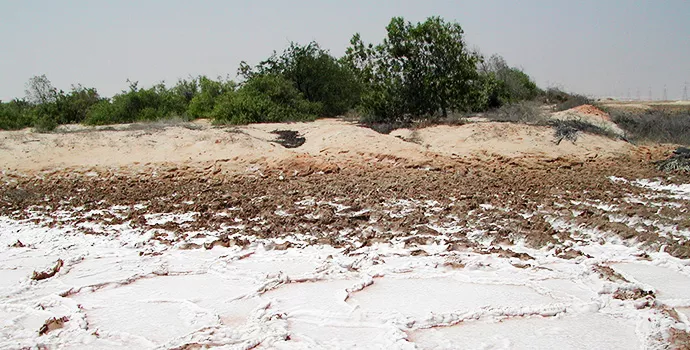Why soil conservation matters
15 November 2016
The soil ecosystem plays a vital role in climate change as it regulates soil carbon sequestration and greenhouse gas emissions.
The world’s soil, however, is in trouble. Experts calculate that, in the last 150 years, the world has lost half of its topsoil, mostly due to wind erosion. According to John Crawford, a professor at the University of Sydney: “A rough calculation of current rates of soil degradation suggests we have about 60 years of topsoil left.” Degradation, which is often caused by human activities including agriculture, is another threat to the health of the world’s soil as it depletes the soil of nutrients and hinders its ability to provide ecosystem services. Today, the majority of soil resources are considered to be in fair, poor, or very poor condition.
In 2015, the United Nations Food and Agriculture Organization (FAO) released Status of the World’s Soil Resources, a publication which warned of falling agricultural productivity as soil continued to be lost and degraded. The report cites a number of factors that contribute to soil loss and degradation including crop-based agricultural practices, overgrazing, deforestation, and the overuse of agrochemicals. Worldwide, soil loss is responsible for the reduction of arable cropland, water system pollution, an increase in floods, and desertification, that is a process in which once-fertile land becomes desert.
For arid and semi-arid regions of the world, such as the Middle East and North Africa (MENA), the consequences of soil degradation and loss are compounded by climate change, water access, and demographic shifts, which place greater burdens on agricultural productivity. Of the 14.9 million sq. km.of land that make up the countries of, among others, Tunisia, Algeria, Morocco, Libya, Egypt, Sudan, Jordan, Lebanon, Syria, Palestine, Iraq, Yemen, Saudi Arabia, Oman, Qatar, the United Arab Emirates, Kuwait, Bahrain, only 6.8 percent is arable. Land degradation in these countries could cost an estimated 9 USD billion per year and is expected to result in decreased crop yields by 2050.
While irrigation is an integral aspect of farming for many areas in the MENA region, the inefficient use of irrigation systems can lead to soil salinization, or a build-up of water soluble salts in soil. This process can hinder crop growth as excess salts prevent plants from taking up water. Water and wind erosion are also major concerns for MENA countries. An estimated 41 million hectares are impacted by water erosion which is exacerbated, in part, by agricultural practices that reduce land cover. Wind erosion is the most prevalent form of environmental degradation in the region and is responsible for roughly 66 percent of soil degradation. Combined, wind and water erosion lead to a loss of fertile topsoil, a reduction in the efficiency of irrigation systems, and hamper agricultural productivity.
There are, however, a number of solutions that can reduce soil loss and improve the health of the soils.
A number of crop practices can reduce soil erosion. Tilling, which creates ridges and furrows in the soil, reduces wind erosion. Providing soil cover, through processes like allowing crop residues to remain in fields after harvesting or intercropping are both sustainable methods of reducing erosion. Crop rotation is another method of erosion reduction and, along with the avoidance of excessive agro-chemical use, can improve soil fertility.
Dr. Abdullah Alshankiti, senior soil management scientist at the International Center for Biosaline Agriculture (ICBA) advocates for policy solutions to help ill-equipped communities manage their soils. Dr. Alshankiti cited Iran as an example for the country’s implementation of nine strategies for sustainable development. Likewise, Egypt has developed strategies for each agro-ecological zone and the United Arab Emirates have developed programs to improve ecological systems, fight desertification, mitigate the effects of climate change, and protect its biodiversity.
Research is also a key component of combatting soil loss and degradation. Gathering data is an essential first step in the process of developing sustainable agricultural strategies. Using remote sensing, terrain analysis, geostatistics and GIS technologies allows soil surveys to be conducted in both a timely and cost- effective manner. Another example of research is a drylands project, carried out through a partnership between ICBA, Young Water Scientists Partnership (YWSP) Small Grants Program, USAID, and Arabian Gulf University. The project examined the use of soil amendments to improve crop productivity in sandy soils and reduce water consumption.
What is more, education and awareness are needed to keep soil issues at the forefront of policy conversations, research agendas, and the general public. Since 2013, the FAO has designated 5 December as World Soil Day in an effort to raise awareness of the issues surrounding soil. Aligned with the celebration of World Soil Day, the Emirates Soil Museum is slated to open on 5 December 2016. A joint project between ICBA and the Abu Dhabi Fund for Development (ADFD), the museum will serve as an information hub for the role of soil in the environment, agriculture, and food security.
“As soil is a non-renewable resource, it is essential to ensure its preservation for food security and a sustainable future,” Dr. Ismahane Elouafi, Director General of ICBA explained. “This requires continued public awareness of the importance of soil and the negative impact of unsustainable uses of soil.”











